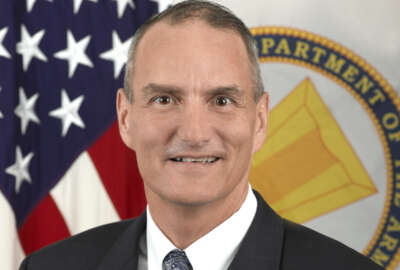
DoD Cloud Exchange: Chris Mayfield, Navy
This discussion with Chris Mayfield is part of Federal News Network's DoD Cloud Exchange.
Chris Mayfield works in a world that requires a lot of juggling. As the chief engineer for cloud and DevSecOps for the Naval Information Warfare Center (NIWC), Pacific, he’s at the center of scores of product developments for the Navy’s information warfare, positioning and navigation, and application development requirements. It primarily serves the surface side of the Navy.
For example, NIWC Pacific is at work on the big Consolidated Afloat Networks and Enterprise Services, or CANES, program, to modernize and standardize ship-board networks and applications.
“We kind of think of ourselves as the biggest nerds in the Navy,” Mayfield said during Federal News Network’s DoD Cloud Exchange. “We primarily run in the IT and C4ISR side of things,” he said, referring to information technology and command, control, communications, computing, information, surveillance and reconnaissance.
Increasingly, Mayfield said, his group is working in the world of artificial intelligence and machine learning, where it uses a multiplicity of commercial clouds to support development. It is also using the cloud more and more as a production environment from which to distribute finished products to Navy ships throughout the world.
Projects range from the basic, like using sensor and operational data to gage the physical condition of ships’ hulls to developing capabilities for unmanned aerial vehicle that launch from those ships’ decks.
Mayfield said his work encompasses basic both research and development that may never result in a deployable product, and the nuts-and-bolts of updating, re-engineering and modernizing existing applications and getting the updates distributed.
A major challenge for NIWC Pacific, Mayfield said, achieving a Tesla-like model for software update distribution. The electric car company regularly updates software wirelessly and with no user intervention. Every car gets updated overnight.
“How do you emulate that within the Navy at, like, the scale of the fleet? That’s the challenge,” Mayfield said, given that the fleet is scattered across the globe and operating under varying network conditions. And, that each ship is, to some degree, a unique “snowflake.”
“You know, we love to joke, especially the developer community, ‘Hey, the admiral wants that red button to be blue.’ So how do you do that at speed, at net scale, in 10 seconds for something that’s 15,000 miles away? That’s the goal. That’s what we’re going to try.”
Mayfield said he envisions a series of cloud-connected DevSecOps pipelines, each to support specific missions and projects.
“But how you do it efficiently — I think, whoever can figure that out for everybody, that is going to be the key,” he said.
That means network architectures are closely connected to efficient cloud use, Mayfield said, as the Navy pursues a decidedly multi-cloud strategy.
“I think of all the cloud providers — Amazon, Google, Oracle, Microsoft Azure — they all have very, very good strengths,” Mayfield said. “But at the same point, it’s about that capability delivery. No matter what that project, or what the program executive officer wants to deliver, we want people to have the best possible path for them to deliver that.”
Mayfield predicted that while the DoD works to flatten network-to-cloud connectivity, over time clouds will come closer to the points of usage be employing edge computing.
Among the virtues of the cloud providers, Mayfield said, was the range of technical services they provide to development shops, together with the ease of using them. Early on, he said, that led to a bit of a wild west in which many small shops in the Navy and throughout DoD signed up with individual cloud contracts.
That’s evolving to a more centralized, brokered model, he said. For example, the Navy has established its own brokers called Navy technical agents “who execute cloud for all the projects at the different labs.”
Copyright © 2025 Federal News Network. All rights reserved. This website is not intended for users located within the European Economic Area.
Tom Temin is host of the Federal Drive and has been providing insight on federal technology and management issues for more than 30 years.
Follow @tteminWFED
Related Stories






